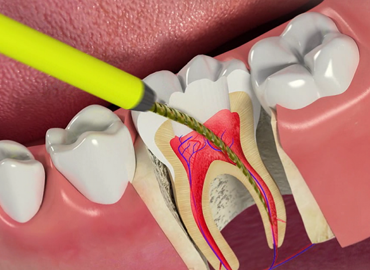Each tooth has a root with at least one root canal initiating the root. The canals contain pulp material consisting of veins and nerve tissue, which help nourish the tooth. When this pulp gets infected because of microbes from decay or injury, it must be taken out and the canal thoroughly cleaned and sterilized. Patients typically need a root canal when there is inflammation/ infection in the roots of a tooth.
RCT or Root canal treatment is a dental procedure to relieve dental pain and save your teeth, despite the fact that the root of the tooth is currently dead. The tooth is as yet holding quick in the jaw bone & is nourished by encompassing tissues. This is important for chewing and biting purposes as well as maintaining jaw structure.
Signs that you need Root Canal Treatment:
- An extreme, painful toothache that might not let you sleep
- Sensitivity to hot or cold items persists even after the sensation has been removed
- Painful experience while chewing or biting food
- A damaged or crooked tooth
- Inflammation or tenderness in the gums
- Unexpected pain that usually starts from the jaw and ends up in head areas, including the ear
- Tooth Decay
- A pimple on the gum that contains blood or pus when drained
Advantages Of Root Canal Treatment:
- Virtually Pain-Free Procedure
- Efficient & Cost-Effective
- Visually Appealing Result
Procedure For Root Canal Treatment
Step 1:
The first and foremost step includes an X-ray which will be done to examine the extent and root of the infection. Before starting the treatment in some cases, if needed local anesthesia will be used.
Step 2:
While making sure all the infected tooth material or if there is any previous filling material will be removed to prepare a cavity and a proper path to the inner part of the tooth (pulp) will be made.
Step 3:
The pulp that is infected will be cleared out completely, canals are shaped and cleaned. All this method will be done to disinfect the pulp.
Step 4:
An inert rubber-like filling material known as Gutta-Percha will be used to fill the clean and disinfected canals and will be sealed with it.
Step 5:
The last and final step is the restoration & crowning. With the help of filling (Cap/Crown cementation), the crown portion of the tooth cavity will be restored.
Post Care For Root Canal Treatment
- This time your tooth will be in a sensitive state, so do not put pressure on the tooth. Until there is no crown on the tooth area, the tooth is unprotected so putting pressure can cause damage to the tooth.
- Avoid eating hard and crunchy food, instead of try to consume soft food until the final touch.
- Be careful while brushing. Keep it light and soft
- Get your dental crown placed as soon as possible
- Visit your dentist asap, if you face any issues or severe pain
